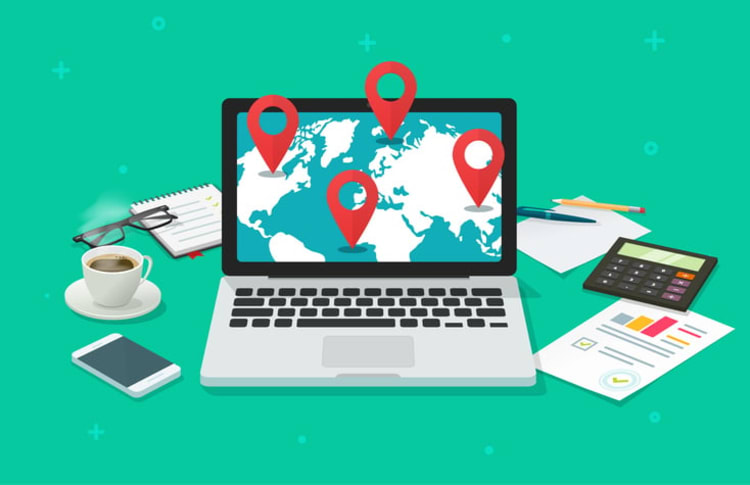Imagine a life where you can work from the pristine beaches of Costa Rica in the morning and explore the bustling streets of Tokyo at night. This dream is now a reality for many digital nomads who have embraced the freedom of learning how to work remotely and travel the world. So, how can you join this growing community and make the most of your remote work and travel experience? Let’s find out!
In this in-depth guide, we’ll explore the steps to embrace the digital nomad lifestyle, set up an efficient remote workspace, navigate time zone differences, build relationships with remote teams, understand legal and financial considerations, adapt to local cultures, stay safe and healthy on the road, and make the most of your how to work remotely and travel experience. So, let’s dive into this exciting world and unlock the freedom of working remotely and traveling with guidance from Kumospace!
Key takeaways
- Embrace the digital nomad lifestyle to work and explore new destinations.
- Find the right job, create a balance between work and life, set up your workspace with a reliable internet connection & choose an ideal location for remote working.
- Network with other digital nomads, stay safe & healthy on the road while making the most of this experience by setting goals & embracing new experiences!
Embracing the digital nomad lifestyle

The digital nomad lifestyle offers:
- The flexibility to work from anywhere in the world
- The opportunity to explore new destinations
- The chance to immerse yourself in local cultures
- The ability to create unforgettable experiences
With the rise of remote jobs and advances in technology, more people are embracing the freedom and flexibility that WFH and remote work offer, leading to the growth of remote companies, an increase in remote employees, and the exploration of various remote work locations.
So, what does it take to successfully embrace the digital nomad lifestyle?
Finding the right remote job
The initial task in adopting the digital nomad lifestyle involves locating the ideal remote job matching your skills and preferences. With countless remote job opportunities available, you can work as a customer support agent, project manager, online English teacher, or even a translator, to name a few. Great resources to find remote jobs include RemoteOK, We Work Remotely, Working Nomads, and Remotive.
To prepare for a remote job, follow these steps:
- Gain knowledge about the company’s remote work policies.
- Ensure you have the right gear, such as a reliable laptop and a comfortable workspace.
- Investigate potential remote job possibilities.
- Prepare yourself with the required tools.
- Commence your digital nomad journey.
Creating a work-life balance
Maintaining a balanced work-life proves vital in securing your well-being during remote work and travel. To make the most of your time, establish a routine that allows you to complete your work efficiently and explore your surroundings. Waking up early and tackling your tasks head-on can open up more opportunities to discover new places later in the day.
Another aspect to consider is staying in one location for a longer period. This allows you to truly immerse yourself in the local culture and build meaningful connections with the locals. Crafting a healthy work-life balance enables you to wholly relish the advantages of the digital nomad lifestyle without jeopardizing your productivity or well-being.
Setting up your remote workspace

A comfortable and inspiring remote workspace is crucial for staying productive and focused. Whether you prefer to work from a cozy home office, a bustling coffee shop, or a physical office, creating an environment that fosters creativity and efficiency is key to your success as a digital nomad.
Thus, we should investigate the necessity for establishing a productive remote workspace.
Reliable Internet connection
A stable and reliable Internet connection is essential for remote workers, as it enables seamless communication and collaboration with your team, as well as the completion of tasks efficiently. To ensure you have a strong internet connection while traveling, consider the following options:
- Research the internet availability and speed in your destination.
- Invest in portable wifi devices, such as the Skyroam Solis X/Solis WIFI, NETGEAR Nighthawk M1 Mobile 4G Router, or GlocalMe G4 Pro Smart 4G Mobile Global Wi-Fi.
- Consider using a mobile hotspot.
In case of internet issues, having backup options like a separate internet service provider, cloud backup services, or remote desktop software can help you continue working without interruption. Maintaining a dependable internet connection is paramount for preserving team connections and completing tasks efficiently, regardless of your global location.
Choosing the perfect location
The location of your remote workspace can significantly impact your productivity and creativity. When choosing the perfect location, consider factors such as:
- Internet connectivity
- Infrastructure
- Time zone
- Cost of living
- Safety and security
- Climate and weather
- Access to amenities
- Visa requirements
- Cultural fit
- Personal preferences
A quiet environment is invaluable for staying focused and productive. Whether you prefer a bustling coworking space, a cozy coffee shop, or the comfort of your own home, find a location that inspires you and enhances your productivity. Selecting an ideal quiet space for your remote workspace can keep you motivated and help you optimize your remote work and travel experience.
Navigating time zone differences

Working remotely across different time zones can offer exciting opportunities, such as increased flexibility in scheduling and access to a global talent pool. However, navigating time zone differences can also pose challenges, such as coordinating meetings and managing deadlines.
We should investigate efficient methods to handle time zone differences, especially when dealing with an eight-hour difference, to guarantee seamless communication and productivity.
Scheduling meetings and deadlines
To plan meetings and deadlines considering time zone differences, use tools like:
These tools will help you coordinate with your team members and ensure everyone can attend.
Scheduling meetings and deadlines across different time zones can lead to more efficient coordination and collaboration, helping your team stay on track and achieve their goals.
Staying productive
Implement strategies to stay productive despite time zone challenges by:
- Creating a dedicated workspace
- Setting boundaries with those around you
- Using noise-cancelling headphones
- Utilizing productivity tools and apps
- Taking regular breaks
- Practicing mindfulness techniques to stay grounded.
Giving precedence to your physical and mental well-being allows you to stay productive and maximize your remote work and travel experience.
Building relationships with remote teams

Establishing resilient relationships with remote teams is vital in promoting collaboration, trust, and understanding, which ultimately enhances productivity and team morale.
Engaging in virtual team bonding activities and overcoming communication barriers can help you form lasting connections with your team, no matter where they are located.
Virtual team bonding
Virtual team bonding is an exciting way to foster a sense of camaraderie and collaboration among remote team members. Some great virtual team bonding activities include participating in team personality assessments, holding regular all-company video meetings, and encouraging non-work conversations and personal connections.
By engaging in these activities, you can strengthen relationships with your team and create a supportive and collaborative remote work environment.
Overcoming communication barriers
Clear and efficient communication is vital for remote teams to stay connected and work together effectively. To overcome communication barriers, you can:
- Set clear communication protocols
- Utilize communication tools
- Foster informal conversations
- Provide language support
- Create a conducive working environment
By using these strategies, your remote team can navigate communication challenges and foster strong connections, leading to improved productivity and team morale.
Legal and financial considerations

Grasping the legal and financial facets of remote work and travel is paramount for a seamless and pleasurable experience. From tax implications to visa requirements, digital nomads must be aware of the rules and regulations that govern their work and travel lifestyle.
Understanding tax implications
Working remotely in different countries can offer potential tax benefits, depending on each country’s tax laws. Researching specific tax laws and understanding your tax responsibilities in your home country while working abroad can help you plan your finances and maximize potential tax benefits.
By being knowledgeable about tax implications, you can ensure compliance and make informed financial decisions on your remote work and travel journey.
Navigating visa requirements
Visa requirements for digital nomads vary from country to country, with some countries offering specific visas for digital nomads and remote workers. To ensure a hassle-free remote work and travel experience, research the specific visa requirements of each country before planning to work remotely there.
Some countries that offer digital nomad visas include:
- Albania
- Romania
- Germany
- Estonia
- South Korea
- Italy
- South Africa
- Colombia
By understanding visa requirements, you can enjoy a seamless transition between countries and make the most of your remote work and travel experience.
Adapting to local cultures

Adjusting to local cultures is a significant element of the digital nomad lifestyle as it assists in connecting with locals, comprehending local work ethics, and integrating within the local culture.
By learning the language and embracing local customs and traditions, you can enrich your remote work and travel experience and create lasting memories.
Learning the language
Learning the local language can greatly enhance your travel experience by enabling you to communicate with locals, immerse yourself in the culture, and form meaningful connections. To learn a new language effectively, leverage language learning apps, immerse yourself in the natural environment of the language and practice persistently.
Some popular language learning resources include Babbel, Duolingo, and Preply. By learning the local language, you can enjoy a more authentic and enriching experience in your chosen destination.
Embracing local customs and traditions
Embracing local customs and traditions allows you to fully immerse yourself in the local culture and participate in cultural experiences and events. By attending local events, trying local cuisine, and engaging in conversations with locals, you can gain a deeper appreciation for the destination you are visiting.
Embracing local customs and traditions can significantly enrich your overall travel experience and make your time as a digital nomad even more memorable.
Staying safe and healthy on the road

Guaranteeing your safety and well-being during remote work and travel is of paramount significance. From travel safety tips to maintaining physical and mental health, taking care of yourself on the road is essential for a successful digital nomad journey.
Travel safety tips
To ensure a secure and enjoyable remote work and travel experience, follow travel safety tips such as:
- Keeping your belongings safe
- Being aware of potential scams
- Ensuring digital security
- Researching health and safety resources for digital nomads
By taking proactive steps to stay safe, such as storing belongings securely, blending in with locals, and carrying a decoy wallet, you can confidently travel, save money, and enjoy the benefits of the digital nomad lifestyle.
Maintaining physical and mental health
Prioritizing your physical and mental health is essential for maintaining productivity and well-being while working remotely and traveling. To stay healthy, you should:
- Maintain a balanced diet
- Exercise regularly
- Get enough sleep
- Practice mindfulness techniques
By prioritizing self-care and seeking support when needed, you can ensure a positive and fulfilling remote work and travel experience.
Making the most of your remote work and travel experience

To optimize your remote work and travel experience, it’s vital to:
- Establish personal and professional goals
- Connect with other digital nomads
- Stay focused and motivated
- Build a supportive community
- Embrace new experiences
By following these steps, you can truly enjoy the unique benefits and freedom of the digital nomad lifestyle.
Setting personal and professional goals
Setting clear personal and professional goals can help you stay focused and motivated while working remotely and traveling. By defining your long-term objectives and breaking them down into smaller, achievable goals, you can prioritize your tasks and measure your progress.
Regularly reviewing and adjusting your goals ensures that you stay on track and make the most of your remote work and travel experience.
Networking with other digital nomads
Connecting with other digital nomads can provide valuable insights, support, and opportunities for collaboration. Platforms like Nomad List, Digital Nomad World, and Meetup.com offer fantastic opportunities to connect with like-minded individuals and build strong professional relationships.
By networking with other digital nomads, you can share experiences, learn from each other, and create a supportive community that enhances your remote work and travel journey.
Summary
Embracing the digital nomad lifestyle offers an unparalleled sense of freedom and adventure. By following the steps outlined in this guide, you can successfully navigate the challenges of remote work and travel, building lasting connections, and creating unforgettable memories along the way.
So why wait? Unlock the freedom of working remotely and traveling with the help of Kumospace, and embark on the journey of a lifetime that combines work and exploration. The world is waiting for you!
Frequently asked questions
Yes, it is possible to work remotely and travel. With the freedom of remote work, you can explore new places while doing the job you love. By organizing a game plan, finding the right workspace, and coordinating with your team, you can be productive and enjoy traveling at the same time.
It's possible to work remotely from another country with the correct visas and a work permit, so long as you are in good standing with your employer and abide by local labor laws. American citizens will still need to pay taxes in the US as usual. If you're an independent contractor, you can choose where you work, otherwise, you'll have to ask your employer for permission.
Remote work has opened up opportunities for more frequent and varied travel. It has improved work-life balance by giving employees extra time to explore and has the potential to save money on transportation, food, and accommodation costs. This trend has greatly disrupted traditional travel habits.
Remote job opportunities for digital nomads are plentiful and varied, including customer support agents, project managers, online English teachers, translators, and web designers.
To ensure a stable and reliable internet connection while working remotely, research the local internet availability and speed, invest in portable wifi devices, and consider using a mobile hotspot.





